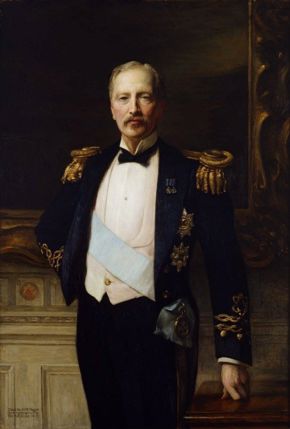The Characters of Kenwood: The First Earl of Iveagh June 8, 2012

H. M. Paget after Sir A. S. Cope, Edward Cecil Guinness, 1st Earl of Iveagh,
c. 1912, oil on canvas, Kenwood House, English Heritage; Iveagh Bequest.
© English Heritage Photo Library
During the run of the exhibition Rembrandt, Van Dyck, Gainsborough: The Treasures of Kenwood House, London, we will fill you in on the lives of the characters that add to the colorful history of the Kenwood estate. Many of the artworks in the show are full-length portraits of glamorous society ladies painted by artists competing in the Royal Academy of Arts exhibitions. Quite a few of these 18th-century beauties—including actresses, courtesans, and other celebrities—would have recognized (and in some cases snubbed) each other had they entered the same reception rooms . . .
The first character we introduce you to must be Edward Cecil Guinness, the first Earl of Iveagh and the third son of Arthur Guinness. (Arthur’s grandfather founded the famous Guinness brewery.) Since Edward Cecil wasn’t the first-born son, he wouldn’t inherit any title, land, or fortune from his family. Instead, he entered the family business straight from school. After his father died in 1868, he bought out his brothers’ shares and started his journey to creating one of the most successful breweries in the world. Thanks to his success—in today’s terms, his annual income was more than £20 million ($33 million)—he was able to retire a multimillionaire and focus on a new ambition.
And what was that? Guinness began assembling a virtual harem: portraits, that is, of the most beautiful women of Georgian-era England. Additionally, his love for his three sons inspired him to collect depictions of youth by Thomas Gainsborough, Thomas Lawrence, Joshua Reynolds, and George Romney. The now-famous art collection does not include many portraits of gentlemen, likely because such paintings were typically kept within families and rarely available on the market. As a permanent public home for his collection, Guinness purchased the Kenwood estate from the sixth Earl of Mansfield in 1925. Guinness never lived there, but upon his death he bequeathed his collection to Kenwood.
Guinness died in 1927 (just shy of his 80th birthday), and as a part of his legacy, he was able to initiate a 1929 Act of Parliament to create at Kenwood “a fine example of the aristocratic home of a gentleman of the 18th century.” In fact, he was so wealthy that Winston Churchill, as Chancellor of the Exchequer, received enough from the estate taxes to reduce the general level of income tax across England. Cheers to Lord Iveagh, indeed!
Stay tuned for more on the characters of Kenwood. To see the fabulous renditions of these personalities up close, visit the exhibition—organized by the American Federation of Arts and English Heritage—while it is on view at the MFAH this summer.





